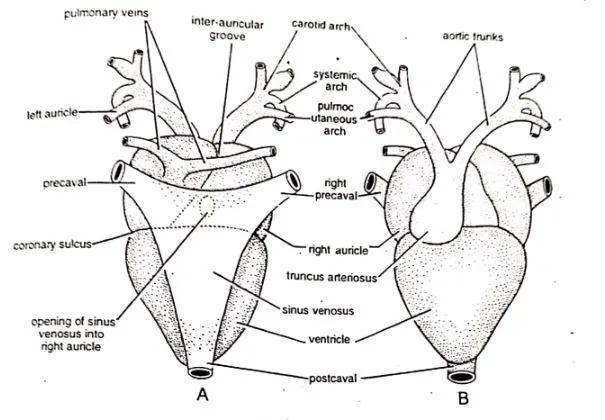Blood Circulatory System of Frog
- The blood circulatory system of frog is closed.
- The whole blood circulatory system of frog consists of blood, heart, arterial system, venous system.
Blood of Frog
- It is the chief circulatory fluid of the body.
- It contains blood plasma and blood corpuscles.
- It is a liquid connective tisse.
1. Blood Plasma
-
-
- It forms the two third part of the blood.
- Almost 90% of the blood plasma is water.
- It contains mineral salts, absorbed food (sugars, proteins), excretory wastes, hormones and other soluble substances.
-
2. Blood Corpuscles
-
-
- There are three types of blood corpuscles and they are erythrocytes, leukocytes and thrombocytes.
- Erythrocytes or red blood corpuscles are oval, nucleated and flattened.
- Erythrocytes bear the respiratory pigment haemoglobin which carry oxygen to the tissues.
- Leukocytes or white blood corpuscles are colorless, nucleated and amoeboid cells.
- Leukocytes are phagocytic, ingesting bacteria and other foreign particles that arrive in blood.
- Thrombocytes or blood platelets play an important role in blood coagulation.
-
Heart of Frog

Fig : Heart of frog; A – Dorsal view; B – Ventral view.
External Features
- It lies mid-ventrally inside the anterior trunk region.
- It is protected by the pectoral girdle.
- It is reddish in color.
- It is somewhat conical or triangular in shape.
- Its broad base is directed anteriorly and the narrow apex is directed posteriorly.
a) Pericardium
-
-
- The heart is enclosed by a sac, called the pericardium.
- It is a thin, transparent, and two-layered sac.
- The outer wall of the pericardium is called the parietal pericardium and the inner wall is called the visceral pericardium.
- Between the two pericardial layers, there is a narrow cavity that contains a fluid called the Pericardial fluid.
- The pericardial fluid protects the heart from friction or mechanical shocks.
-
b) Chambers of Heart
-
-
- Frog’s heart is three chambered; two auricles and a ventricle.
- The two auricles are externally demarcated by the inter-auricular groove.
- The two auricles are clearly marked off from the ventricle by the auriculo-ventricular groove.
- The heart of frog has two additional chambers and they are sinus venosus and truncus arteriosus.
- Sinus venosus is formed by the union of three large caval veins; two anterior precavals and one posterior postcaval.
- The truncus arteriosus bifurcates into two branches and each branch further divides into three arches and they are carotid, systematic and pulmocutaneous.
-
Internal Features
a) Auricles
-
-
- The two auricles are thin-walled.
- They are completely separated from each other by the inter-auricular septum.
- The right auricle is larger than the left.
- The sinus venosus opens into right auricle through the sinu-auricular aperture.
- Both auricles open into the ventricle through the auriculo-ventricular aperture which is guarded by the auriculo-ventricular valves.
-
b) Ventricle
-
-
- The ventricle has thick muscular and spongy wall.
- The cavity of ventricle is greatly reduced.
- The flaps of auriculo-ventricular valves are connected to the wall of ventricle by thread-like chordae tendineae.
-
c) Truncus Arteriosus
-
-
- The opening of ventricle into truncus arteriosus is guarded by three semilunar valves.
- The valves prevent the backflow of blood.
- The truncus arteriosus bifurcates into two branches and each branch further divides into three arches and they are carotid, systematic and pulmocutaneous.
-
Working of Heart
- Contraction of the heart is called systole and the relaxation of the heart is called diastole.
- Sinus venosus receives the deoxygenated blood from the venous system.
- Then the sinus venosus contracts. The deoxygenated blood from sinus venosus is forced to the right auricle.
- Meanwhile the oxygenated blood from the lungs is poured into the left auricle.
- Then the two auricles contract to force their blood into the ventricle.
Arterial System of Frog
- Arteries carry blood away from the heart.
- The arterial system of frog begins with the truncus arteriosus.
- The truncus arteriosus divides into right and left branches. Both branches later subdivides into three major aortic arches and they are common carotid arch, systemic arch and pulmocutaneous arch.
- The common carotid arch divides into two branches and they are external carotid and internal carotid.
- The common carotid arch supplies blood to the head.
- The systemic arch is the longest of the three arches.
- The two systemic arches gives off three arteries and they are oesophageal, occipito-vertebral and subclavian arteries.
- The both systemic arches later join with each other behind the heart to form the dorsal aorta.
- The dorsal aorta gives off five types arteries and they are coeliaco-mesenteric, gonadial, renal, posterior mesenteric and common iliac arteries.
- The pulmocutaneous arches divide into two arteries and they are pulmonary and cutaneos artery.
- The pulmonary artery supplies blood to the lungs and the cutaneous artery supplies blood to the skin.
Venous System of Frog
- The venous system collects blood and returns to the heart.
- The venous system has four parts and they are pulmonary veins, caval veins, renal portal veins, and hepatic portal veins.
- Oxygenated blood from the lungs are collected by the two pulmonary veins.
- There are three caval veins. Of them two are anterior vena cava or precavals and one is posterior vena cava or postcaval.
- All the caval veins open into the sinus venosus.
- Each precaval is formed by the union of three veins and they are external jugular, innominate and subclavian veins.
- The postcaval receives renal veins, genital veins and hepatic veins before opening into the sinus venosus.
- Frog has two well-developed portal systems. They are the renal portal system and the hepatic portal system.
- The veins which carry blood to a capillary system in the kidneys constitute the renal portal system.
- A large hepatic portal vein is formed by the union of several branches from stomach, intestine, pancreas and spleen.
——————-THE END——————-
Read More:
- Respiratory System of Frog | Diagram
- External Morphology of Frog | Diagram
- Digestive system of Frog with Diagram
- Urinogenital System of Frog | Diagram
- Nervous System and Sense Organs of Frog | Diagram
- Hoplobatrachus tigerinus (Previously Rana tigrina) | Indian Bull Frog
- General Characters of All Classes of Vertebrates.
Reference:

